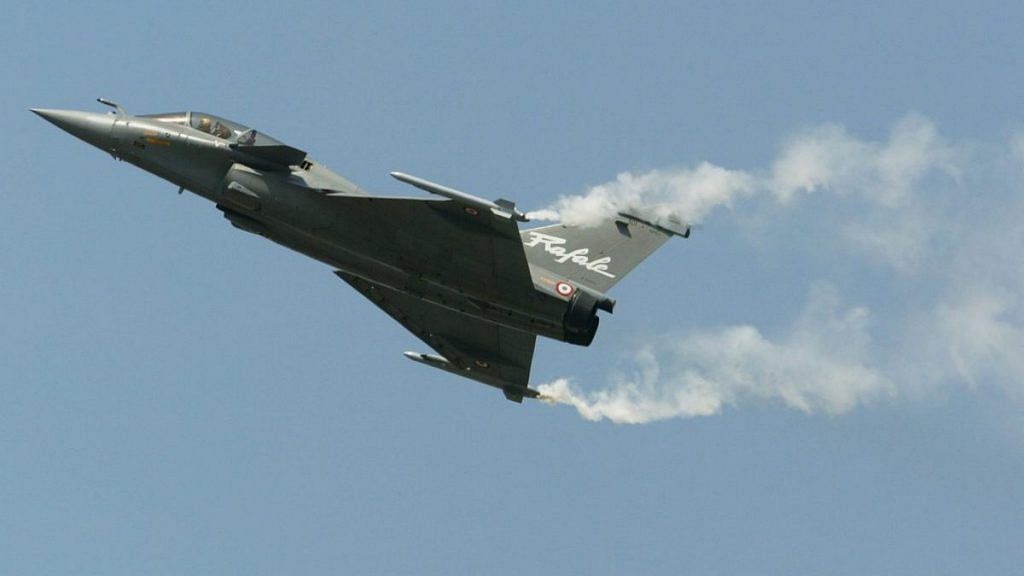Rafale controversy reveals pitfalls of both excessively centralised decision-making and of emphasis on public positioning rather than strategic outcomes.
The no-confidence motion debate in Parliament highlighted the knots into which the Narendra Modi government has tied itself over the purchase of the Rafale aircraft. Defence minister Nirmala Sitharaman brandished the agreement with France on Exchange and Reciprocal Protection of Classified or Protected Information—an agreement originally inked in 2008 and renewed in March 2018 during President Macron’s visit. However, Sitharaman’s finger-wagging rectitude does not explain why the government is unwilling to disclose full details of the price of the aircraft even to a privileged committee.
The agreement, as the minister of state for defence Subhash Bhamre told Parliament earlier this year, “defines the common security regulations applicable to any exchange of classified and protected information between the two countries”. The French government has helpfully clarified that the agreement “commits to protect the classified information provided by the partner, which could, in particular, impact the security and operational capabilities of the defence equipment”.
The information alluded to here clearly pertains to the operational and technical capabilities of the aircraft—not its cost. After all, Sitharaman had committed herself to sharing the commercial details before she pedalled back and sought refuge under this agreement. Why, then, is the government so averse to placing these details on the record?
In fact, ministry of defence officials have provided important details in background briefings to journalists—details that help us understand why the government is so cagey about the Rafale deal. In September 2016, Ajai Shukla reported that the average cost of each of the 36 jets was €91.7 million. With India-specific enhancements—helmet mounted display sights, radar warning receiver, low band jammer, radio altimeter, Doppler radar, cold weather startup—the price of each Rafale went up to €138.9 million. In addition, the government had paid €2.8 billion for weaponry (€710 million), spare parts (€1.8 billion) and performance-based logistics support (€353 million).
The government insisted that this was a better deal than the one previously on offer. In a written statement on 7 February 2018, the ministry of defence claimed: “The deal secured by the [NDA] government is better in terms of capability, price, equipment, delivery, maintenance, training, etc., than that notionally negotiated by the then [UPA] government”. A few weeks later, Sushant Singh reported the ministry’s stance as explained by its officials. The nub of their argument was that while Rafale had originally submitted a bid to the previous government with a per unit price of €79 million, this would have amounted in 2015 to €100.85 million —owing to an inbuilt cost escalation formula. By comparison, the price of each of the ‘bare’ 36 Rafale bought in 2016 was €91.7 million. The additional requirements, which pushed the price per unit up to €138.9 million, were “not even thought of in 2011”.
These arguments are problematic on several counts. For starters, the headings under which the additional costs are being explained are questionable. For instance, ‘weather and terrain compatibility’ or ‘India specific enhancements’ were also part of the original bid. It is incorrect and misleading to say the government had not contemplated them in 2011.
Further, the additional weapon systems and other requirements being paid for in 2016 deal are a direct result of the decision to scrap the original process and go for just 36 fighters. Since the government decided to buy only 36 aircraft instead of 126, the Air Force insisted that these ought to be kitted out better. How tenable, then, is the claim that we should treat these additional costs as entirely separate from the cost of the aircraft?
Most importantly, the government’s claim that the original Rafale bid amounted to €100.85 million in 2015 uses the cost escalation formula advanced by Dassault Aviation. This was, in fact, one of the most contested issues in the negotiations with Dassault until 2014. It was not a negotiated cost between Dassault and the UPA government. It is utterly inappropriate to compare a price under negotiation with the price secured for the 2016 deal. The ministry’s resort to the euphemism ‘notionally negotiated’ price gave the game away. Eventually, Bhamre conceded in response to another parliamentary question in March 2018 that the two deals “cannot be compared”.
By the same token, however, the government cannot insist that it has secured a better deal. The nub of the matter is the Prime Minister’s claim—when announcing in April 2015 the scrapping of the older process and the purchase of 36 Rafale aircrafts—that this would be on better terms. It is primarily to defend this claim that the government has performed such contortions on this issue. This decision, it has transpired, was taken without consulting the cabinet committee on security or the ministry of defence. It is not clear if the Air Force was on board at the time of this announcement. The entire process reveals the pitfalls both of the excessively centralised decision-making in the government and of the emphasis on public positioning rather than strategic outcomes.
Some analysts have pointed out that the government’s reluctance to place on record the costs of the aircraft also stems from the fact that these have been modified for the delivery of nuclear weapons. This may well be true, but officials have already shared with journalists details of the modifications without anyone raising an eyebrow. Nothing precludes the Modi government from disclosing the costs to the parliamentary standing committee on defence and untangling itself from this web of controversy.
